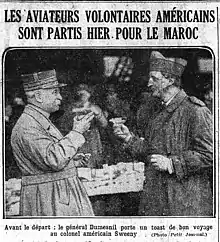
The Escadrille Chérifienne (Cherifian Squadron) or Escadrille Américaine (American Squadron) was an American squadron fighting for the French colonial Empire during the Rif War. It was attached to the Moroccan Royal Guard, or Garde Chérifienne.
Formation
Colonel Charles Sweeny, an American pilot who had served in World War I,[1] proposed organizing a squadron of American pilots to assist the French in Morocco, to French Prime Minister Paul Painlevé, who "warmly welcomed the Colonel’s request."[2]
Seeking "volunteers," Sweeny sent a telegram to a number of World War I veterans in the US in June 1925. By July, he had 17 volunteers, 12 of whom were pilots, including Paul Ayres Rockwell, had served France in World War I.[3][4] The American volunteers were inducted into the French Foreign Legion in July, and their squadron was named Escadrille Cherifienne, 19th Squadron of the Moroccan Aviation Regiment.[5] It was legally attached to the Sultan's Guard, and not to French forces.[6][7]
In a telegram to the French résident général in Morocco Hubert Lyautey, the Prime Minister and Minister of War of France Paul Painlevé said: "This American expression of solidarity seems particularly interesting at the moment and capable of bringing a share of American propaganda to our cause, strengthening American sentiment against the aggression of Abd el-Krim."[5]
Operations
_bpt6k46037774_4.jpg.webp)
The unit was activated on August 7, 1925.[8] It operated seven Bréguet 14 light bombers. The Squadron was assisted by a 59-man French ground crew.[8]
In Morocco, the American volunteers of the Escadrille Cherifienne were based in Beni Malek.[9] The Escadrille bombed the Moroccan city of Chefchaouen on September 17, 1925.[1]
The Escadrille was cited at the order of the (French) Occupation Troops of Morocco on October 15, 1925.[8]
Polemics
The US Department of State instructed its consul at the American Legation in Tangier, Maxwell Blake, to warn the Americans that they would risk the revocation of their US citizenship, imprisonment, and fines if they battled "against a people with whom the United States had no quarrel."[10] The American opinion was shocked by American pilots killing Rifian people. The French Left also saw Rifian commander Abd el-Krim as a Republican leader fighting for liberty.[6]
The French aviators in Morocco and the French new commander Philippe Pétain disapproved the use of foreign mercenaries.[6]
Members
Association_des_bpt6k96881165_26_(1).jpg.webp)
- Colonel Charles Michael Sweeny[11][12]
- Captain Paul Ayres Rockwell[11]
- Commander James Sussan/Susson, Canadian former commander pilot in the Royal Air Force of the United Kingdom [11][12]
- Donald Mac Gibeny, former pilot of United States Air Force[11]
- Captain Samuel J. Mustain, former pilot of United States Air Force[11][13]
- Doctor James V Sparks, who enlisted as a medic[11][12]
- Captain George Butts[11][12]
- George Rehm[11]
- Lieutenant Charles W. Kerwood[12][11]
- Commander Grandville Pollock[12][11]
- Lieutenant-Colonel Austin G. Parker[12][11]
- Captain Reginald H. Weller[12][11]
- Captain Graham[11]
- Captain Lansing C. Holden[11]
- Captain William G. Bullin[11]
- Lieutenant William S. Cousins[12]
Motivation
On the motivation of the rogue American volunteer pilots, Sweeney wrote, "In our view, France, in fighting Abdel Krim, is fighting the cause of the white man's civilization, and all who have formed this squadron know enough of the world to appreciate what the white man's civilization means."[14]
Most of the pilots were interested in an adventurous life and the historian William Dean refutes the importance of the White supremacist views of the pilots.[6]
References
- 1 2 "Why Americans Volunteered to Bomb a Moroccan Mountain Town in 1925". Code and Dagger. Retrieved 2019-07-14.
- ↑ Roberts, Charley. Charles Sweeny, the man who inspired Hemingway. ISBN 1476669945. OCLC 1011663811.
- ↑ Yabiladi.com. "History : When an American squadron violated US neutrality laws, bombing Chefchaouen". en.yabiladi.com. Retrieved 2019-07-14.
- ↑ Roberts, Charley; Hess, Charles P. (2017-09-08). Charles Sweeny, the Man Who Inspired Hemingway. McFarland. ISBN 9781476669946.
- 1 2 Roberts, Charley; Hess, Charles P. (2017-09-08). Charles Sweeny, the Man Who Inspired Hemingway. McFarland. p. 153. ISBN 9781476669946.
- 1 2 3 4 Dean, William (2007-03-15). "Des Américains dans la guerre du Rif". Revue historique des armées (in French) (246): 46–55. ISSN 0035-3299.
- 1 2 Azzou, El-Mostafa (2003). "L'escadrille Lafayette : des aviateurs américains dans la guerre du Rif: (1921-1926)". Guerres mondiales et conflits contemporains (in French). 209 (1): 57. doi:10.3917/gmcc.209.0057. ISSN 0984-2292.
- 1 2 3 4 Pesquies, Simone (1990). "L'aéronautique militaire française dans la guerre du Rif". Revue du Nord. 72 (285): 317–367. doi:10.3406/rnord.1990.4530.
- ↑ "Excelsior : journal illustré quotidien : informations, littérature, sciences, arts, sports, théâtre, élégances". Gallica. 1925-10-03. Retrieved 2019-07-15.
- ↑ Roberts, Charley; Hess, Charles P. (2017-09-08). Charles Sweeny, the Man Who Inspired Hemingway. McFarland. ISBN 9781476669946.
- 1 2 3 4 5 6 7 8 9 10 11 12 13 14 15 texte, Parti social français Auteur du (1925-08-06). "Le Petit journal". Gallica. Retrieved 2019-07-19.
- 1 2 3 4 5 6 7 8 9 texte, Association des dames françaises Auteur du (January 1926). "Bulletin de l'Association des dames françaises / Croix-rouge française". Gallica. Retrieved 2019-07-19.
- ↑ Baltimore Sun, U.S. Flyers in Riff Termed Civilian Slayers in Report, 17 Oct 1925, p. 1, 10
- ↑ Deacon, Richard (1972). One Man's Wars: The Story of Charles Sweeny, Soldier of Fortune. Barker. ISBN 9780213994327.